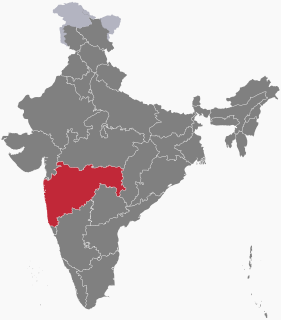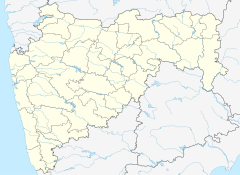
Satara is a city located in the Satara District of Maharashtra state of India, near the confluence of the river Krishna and its tributary, the Venna. The city was established in the 16th century and was the seat of the Raja of Satara, Chhatrapati Shahu. It is the headquarters of Satara Tahsil, as well as the Satara District. The city gets its name from the seven forts (Sat-Tara) which are near the city.
Chhatrapati is a royal title from the Indian subcontinent. It is often taken to be the equivalent of king or lord, and was used by the Maratha. The word ‘Chhatrapati’ is a tatpurusha Sanskrit compound of chhatra and pati (master/lord/ruler). The parasol was considered a symbol of absolute, or even universal, sovereignty and consecrated kingship, and has been used by monarchies outside of India, as well. The title indicates a person who is a sovereign ruler over other princes, and not a vassal. In contrast, the Indian titles of Maharaja or Raja, Yuvraj, Rajkumar or Kumar, and Senapati, reflect a range of European equivalent meanings, from King, Crown Prince, and Prince, to Duke, Count, or Lord. Shivaji adopted 'Chhatrapati' it since other titles were bestowed by other lieges and paramount rulers, like the Adilshahi or Mughals.
The Bhosle are a prominent group within the Maratha clan system. Traditionally a warrior clan, some members served as rulers of several states in India, the most prominent being Shivaji, the founder of the Maratha Empire which opposed the rule of Mughal Empire in Indian subcontinent. His successors ruled as chhatrapatis (maharajas) from their capital at Satara, although de facto rule of the empire passed to the Peshwas, the Maratha hereditary chief ministers, during the reign of Shahu I. In addition to the Bhonsle chhatrapatis of Satara, rulers of the Bhonsle clan established themselves as junior branch of chhatrapatis at Kolhapur, and as maharajas of Nagpur in modern-day Maharashtra in the 18th century.
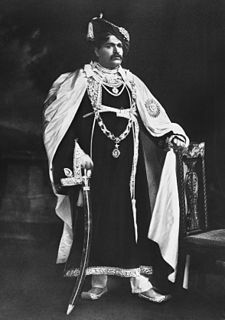
Shahu of the Bhosle dynasty of Marathas was a Raja and a Maharaja (1900-1922) of the Indian princely state of Kolhapur. Chhatrapati Shahu Maharaj, also known as Rajarshi Shahu was considered a true democrat and social reformer. First Maharaja of the princely state of Kolhapur, he was an invaluable gem in the history of Maharashtra. Greatly influenced by the contributions of social reformer Jyotiba Phule, Shahu Maharaj was an ideal leader and able ruler who was associated with many progressive and path breaking activities during his rule. From his coronation in 1894 till his demise in 1922, he worked tirelessly for the cause of the lower caste subjects in his state. Primary education to all regardless of caste and creed was one of his most significant priorities.
The Battle of Palkhed was fought on February 28, 1728 at the village of Palkhed, near the city of Aurangabad, Maharashtra, India between the Maratha Peshwa, Baji Rao I and the Nizam-ul-Mulk, Asaf Jah I of Hyderabad wherein, the Marathas defeated the Nizam.
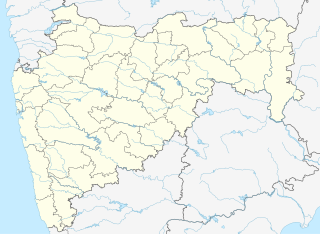
Kagal is a town in Kolhapur district of the Indian state of Maharashtra.

The Maratha Conquests were a series of conquests in the Indian subcontinent which led to the building of the Maratha Empire. These conquests were started by Shivaji in 1659 from the victory at the Battle of Pratapgad against Bijapur. The empire was interrupted by the Mughal conquests of south India by Emperor Aurangzeb and lost its independence as well as execution of their kings which continued until the death of Bahadur Shah I in 1712. Afterwards, the Marathas conclusively defeated and overtook major territories of the Mughal Empire in the Indian subcontinent and its vassals. It ended with the eventual fall of the Maratha Empire after the second and the third Anglo-Maratha Wars.

Tuljabhavani Temple is a Hindu temple dedicated to the goddess Bhavani. It is located in Tuljapur in Osmanabad district of Maharashtra and is considered as one of the 51 Shakti Pithas. It is situated 45 km from Solapur.The temple was built in c. 12th century CE.

Maharashtra attracts tourists from different states and foreign countries.It was the second most visited Indian state by foreigners and fourth most visited state by domestic tourists in the country in 2014. Aurangabad is the tourism capital of Maharashtra. Major urban cities include : Mumbai, Pune, Nashik, Aurangabad, Nanded and Nagpur.

Vishalgad was a jagir during the Maratha Empire and then later part of the Deccan States Agency of the British Raj. It was governed by Deshastha Brahmins, who were feudatories of Kolhapur State.
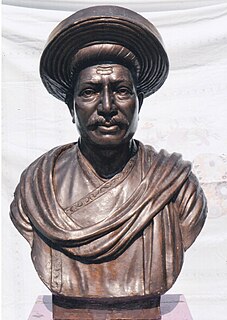
Ramchandra Neelkanth Bawadekar (1650–1716), also known as Ramchandra Pant Amatya, served on the Council of 8 as the Finance Minister (Amatya) to Emperor (Chhatrapati) Shivaji dating from 1674 to 1680. He then served as the Imperial Regent to four later emperors, namely Sambhaji, Rajaram, Shivaji II and Sambhaji II. He authored the Adnyapatra, a famous code of civil and military administration, and is renowned as one of the greatest civil administrators, diplomats and military strategists of the Maratha Empire.

Panhala fort, is located in Panhala, 20 kilometres northwest of Kolhapur in Maharashtra, India. It is strategically located looking over a pass in the Sahyadri mountain range which was a major trade route from Bijapur in the interior of Maharashtra to the coastal areas. Due to its strategic location, it was the centre of several skirmishes in the Deccan involving the Marathas, the Mughals and the British East India Company, the most notable being the Battle of Pavan Khind. Here, the queen regent of Kolhapur State, Tarabai, spent her formative years. Several parts of the fort and the structures within are still intact.

Vijaydurg, the oldest fort on the Sindhudurg coast, was constructed during the regime of Raja Bhoja II of the Shilahar dynasty and restructured by Shivaji Maharaj.

Kolhapur State or Kolhapur Maratha Kingdom (1710–1949) was a Maratha princely State of British India, under the Deccan Division of the Bombay Presidency, and later the Deccan States Agency. It was considered the most important of the Maratha principalities with the others being Baroda State, Gwalior State and Indore State. Its rulers, of the Bhonsle dynasty, were entitled to a 19-gun salute – thus Kolhapur was also known as a 19-gun state. The state flag was a swallow-tailed orange pennant.
The following list includes a brief about the titles of nobility or orders of chivalry used by the Marathas of India and by the Marathis/Konkanis in general.
Savarde is a small village situated in the southwest corner of Maharashtra, India along the banks of Dudhganga river. The population of Savarde was approximately 2,345 as per the 2011 census. As it is in the Maharashtra state, the main language spoken here is Marathi. Blessed by divine power of the goddess Kalamma which is also symbol of Unity in integrity for all casts.
Sambhajiraje Chhatrapati is hailing from the direct lineage of the legendary Chhatrapati Shivaji Maharaj, Kolhapur royal family.

Shriniwasrao Parshuram, popularly known as Shripatrao Pratinidhi or Shripatrao Pant Pratinidhi, was a General of the Maratha Empire. He served as Pratinidhi during Chhatrapati Shahu I reign. After the death of his father Parshuram Pant Pratinidhi in 1718, Shripat Rao won the favour of Shahu by his brilliant efforts as a soldier fighting many battles in the defence of the Maratha Empire. In 1718, he was appointed as the Pant Pratinidhi of Maratha Empire.


